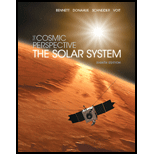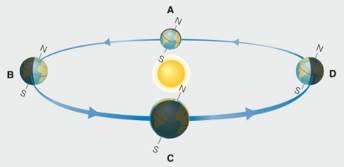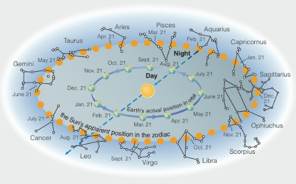
Use the following questions to check your understanding of some of the many types of visual information used in astronomy. For additional practice, try the Chapter 2 Visual Quiz at MasteringAstronomy®.

The figure above is a typical diagram used to describe Earth's seasons.

The figure above (based on Figure 2.14) shows the Sun’s path through the constellations of the zodiac.
5. Given that Earth's actual distance from the Sun varies by less than 3% over the course of a year, why does the diagram look so elliptical?
a. lf correctly shows that Earth is closest to the Sun at points A and C and farthest at points B and D.
b. The elliptical shape is an effect of perspective, since the diagram shows an almost edge-on view of a nearly circular orbit.
c. The shape of the diagram is meaningless and is done only for artistic effect.
Want to see the full answer?
Check out a sample textbook solution
Chapter 2 Solutions
Cosmic Perspective, The: The Solar System and MasteringAstronomy with Pearson eText -- ValuePack Access Card, 8/e
- How Do We Know? Describe the differences between a hypothesis, a theory, and a law. Give an example of each.arrow_forwardExplain three lines of evidence that argue against the validity of astrology.arrow_forward- How far (in km) is 3.5 lightyears(ly) – the distance traveled by light in one Earth year? - How much is this same value in parsecs and (C) in astronomical units (AU)? Use 299,732 km/s for the speed of light (c) and 1 year = 365 days. Show your solution and write your answer in both regular notation and scientific notation.arrow_forward
- 1. If people on Earth were viewing a total lunar eclipse, what would you see from your home on the Moon? Draw a diagram. 2. Why were the main reasons why the idea that the Earth was at the center of the universe lasted so long? 3. Discuss in 2 paragraphs the observations made by Galileo that disproved Geocentrism. Which one do you think was the most important? 4. Write down a hypothesis and observational experiment to test one of Newton’s laws of motion. EXPLAIN YOUR REASONING! 5. One of the first exoplanets discovered orbits the star 51 Pegasi with a period of just 4.2 days. 51 Pegasi is very similar to the Sun. Use Kepler’s laws to find the distance (in astronomical units) between the planet (unofficially named Bellerophon) and its star. SHOW YOUR WORK! 6. How does halving the distance between two objects affect the gravitational force between them? 7. Suppose the Sun were somehow replaced by a star with five times as much mass. What would happen to the gravitational force between…arrow_forwardIn the figure below, Planet X is moving in a perfectly circular orbit around its companion star.The time between each position shown is exactly one month: 1. Write down Kepler’s second Law of planetary motion.2. Does the planet obey Kepler’s second law? How do you know?3. If you carefully watched this planet during the entire orbit, would its speed be increasing, decreasing, orstaying the same? How do you know?arrow_forwardIN NOT MORE THAN 300 WORDS describe the ancient idea about the position of the earth relative to the other heavenly bodies. Explain why it was reasonable for them to believe that the earth was the center of the universe.arrow_forward
- For this short response assignment, your job is to demonstrate your understanding of SI units and how they can be applied on an astronomical scale. To do this, answer each of the following with a brief explanation of the mathematics used to get there.The speed of light is 3*10^8 m/s (aka 300,000,000 meters per second). What is the speed of light in centimeters per second, kilometers per second, and miles per hour? (Hint: there are roughly 1.6 km per mile and 3600 seconds per hour) Remember to show the math; If light from the closest star to our solar system takes about 4.2 years to get to us, how far away is that star in units of Gm (aka Gigameters)? Again, explain your work.arrow_forwardBased on what you've learn on the impact of the Earth-Sun distance on the seasons, what can you say about the the cause of the seasons? (Give ALL correct answers, i.e., B, AC, BCD...)A) Earth's axis is tilted an an angle of 23.5 degrees compared to a line perpendicular (straight up and down) to its orbit, which is the main cause for the seasons.B) Earth's speed varies in its orbit around the Sun, giving us summer when Earth is moving fastest and winter when Earth is moving slowest.C) The Earth-Sun distance play a major role in creating seasons on Earth.D) The tilt of Earth's axis causes the Northern Hemisphere to be closer to the Sun than the southern hemisphere in summer, and vice versa in winter. E) The tilt of Earth's axis causes different portions of the Earth to receive more or less direct sunlight at different times of year.F) Earth's Northern Hemisphere is always tilted away from the Sun at an angle of 23.5 degrees.G) Earth's Northern Hemisphere is always tilted toward the Sun…arrow_forward1. Why were the main reasons why the idea that the Earth was at the center of the universe lasted so long? 2. Discuss in 2 paragraphs the observations made by Galileo that disproved Geocentrism. Which one do you think was the most important? 3. Write down a hypothesis and observational experiment to test one of Newton’s laws of motion. EXPLAIN YOUR REASONING! 4. One of the first exoplanets discovered orbits the star 51 Pegasi with a period of just 4.2 days. 51 Pegasi is very similar to the Sun. Use Kepler’s laws to find the distance (in astronomical units) between the planet (unofficially named Bellerophon) and its star. SHOW YOUR WORK! 5. How does halving the distance between two objects affect the gravitational force between them? 6. Suppose the Sun were somehow replaced by a star with five times as much mass. What would happen to the gravitational force between the Earth and the Sun? 7. How long would the Earth year last in this last case? (hint: Newton’s version of Kepler’s 3rd…arrow_forward
- Explain what is meant by the distance ladder in astronomy. Describe briefly how each “rung” of the distance ladder is calibrated so that a reliable measure of distance can be obtained using each of the methods. State clearly the range of distances that can be measured by each method that makes up the distance ladder.arrow_forwardSuppose you are on a strange planet and observe, at night, that the stars do not rise and set, but circle parallel to the horizon. Next, you walk in a constant direction for 8000 miles, and at your new location on the planet, you find that all stars rise straight up in the east and set straight down in the west, perpendicular to the horizon. How could you determine the circumference of the planet without any further observations? What is the circumference, in miles, of the planet?arrow_forwardWhat is the difference between asterism d a constellation? Give some examples.arrow_forward
 AstronomyPhysicsISBN:9781938168284Author:Andrew Fraknoi; David Morrison; Sidney C. WolffPublisher:OpenStax
AstronomyPhysicsISBN:9781938168284Author:Andrew Fraknoi; David Morrison; Sidney C. WolffPublisher:OpenStax
 Stars and GalaxiesPhysicsISBN:9781305120785Author:Michael A. Seeds, Dana BackmanPublisher:Cengage Learning
Stars and GalaxiesPhysicsISBN:9781305120785Author:Michael A. Seeds, Dana BackmanPublisher:Cengage Learning
 Stars and Galaxies (MindTap Course List)PhysicsISBN:9781337399944Author:Michael A. SeedsPublisher:Cengage Learning
Stars and Galaxies (MindTap Course List)PhysicsISBN:9781337399944Author:Michael A. SeedsPublisher:Cengage Learning Foundations of Astronomy (MindTap Course List)PhysicsISBN:9781337399920Author:Michael A. Seeds, Dana BackmanPublisher:Cengage Learning
Foundations of Astronomy (MindTap Course List)PhysicsISBN:9781337399920Author:Michael A. Seeds, Dana BackmanPublisher:Cengage Learning





